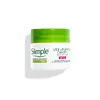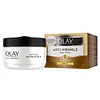Simple Skincare Kind to Skin Vital Vitamin Day Cream SPF 15 Versus Olay Anti-Wrinkle Pro Vital Anti-Ageing Day Moisturiser SPF15
What's inside
What's inside
 Key Ingredients
Key Ingredients

 Benefits
Benefits

 Concerns
Concerns

 Ingredients Side-by-side
Ingredients Side-by-side

Water
Skin ConditioningEthylhexyl Methoxycinnamate
UV AbsorberDicaprylyl Carbonate
EmollientGlycerin
HumectantHydrogenated Polydecene
EmollientCetearyl Alcohol
EmollientButyl Methoxydibenzoylmethane
UV AbsorberDimethicone
EmollientCaprylic/Capric Triglyceride
MaskingButylene Glycol
HumectantBisabolol
MaskingBHT
AntioxidantCaprylyl Glycol
EmollientCetyl Alcohol
EmollientHydrogenated Polyisobutene
EmollientNiacinamide
SmoothingPhenoxyethanol
PreservativePrunus Amygdalus Dulcis Oil
Skin ConditioningSodium Polyacrylate
AbsorbentSodium Stearoyl Glutamate
CleansingStearyl Caprylate
EmollientStearyl Heptanoate
EmollientSucrose Polystearate
EmollientTocopherol
AntioxidantTocopheryl Acetate
AntioxidantZingiber Officinale Root Extract
MaskingWater, Ethylhexyl Methoxycinnamate, Dicaprylyl Carbonate, Glycerin, Hydrogenated Polydecene, Cetearyl Alcohol, Butyl Methoxydibenzoylmethane, Dimethicone, Caprylic/Capric Triglyceride, Butylene Glycol, Bisabolol, BHT, Caprylyl Glycol, Cetyl Alcohol, Hydrogenated Polyisobutene, Niacinamide, Phenoxyethanol, Prunus Amygdalus Dulcis Oil, Sodium Polyacrylate, Sodium Stearoyl Glutamate, Stearyl Caprylate, Stearyl Heptanoate, Sucrose Polystearate, Tocopherol, Tocopheryl Acetate, Zingiber Officinale Root Extract
Water
Skin ConditioningGlycerin
HumectantEthylhexyl Salicylate
UV AbsorberNiacinamide
SmoothingButyl Methoxydibenzoylmethane
UV AbsorberIsopropyl Isostearate
EmollientOctocrylene
UV AbsorberPhenylbenzimidazole Sulfonic Acid
UV AbsorberCaprylic/Capric Triglyceride
MaskingDimethicone
EmollientPanthenol
Skin ConditioningTitanium Dioxide
Cosmetic ColorantTocopheryl Acetate
AntioxidantDimethiconol
EmollientSorbitan Stearate
EmulsifyingTriethanolamine
BufferingStearyl Alcohol
EmollientSodium Acrylates Copolymer
Cetyl Alcohol
EmollientPolyethylene
AbrasiveAluminum Starch Octenylsuccinate
AbsorbentBehenyl Alcohol
EmollientCetearyl Alcohol
EmollientCetearyl Glucoside
EmulsifyingStearic Acid
CleansingPEG-100 Stearate
Disodium EDTA
PEG-30 Dipolyhydroxystearate
EmulsifyingSorbitan Oleate
EmulsifyingCeteareth-6
EmulsifyingBenzyl Alcohol
PerfumingMethylparaben
PreservativeEthylparaben
PreservativePropylparaben
PreservativeParfum
MaskingHydroxyisohexyl 3-Cyclohexene Carboxaldehyde
MaskingLinalool
PerfumingCitronellol
PerfumingBenzyl Salicylate
PerfumingAlpha-Isomethyl Ionone
PerfumingLimonene
PerfumingEugenol
PerfumingCoumarin
PerfumingGeraniol
PerfumingBenzyl Benzoate
AntimicrobialCI 19140
Cosmetic ColorantCI 17200
Cosmetic ColorantWater, Glycerin, Ethylhexyl Salicylate, Niacinamide, Butyl Methoxydibenzoylmethane, Isopropyl Isostearate, Octocrylene, Phenylbenzimidazole Sulfonic Acid, Caprylic/Capric Triglyceride, Dimethicone, Panthenol, Titanium Dioxide, Tocopheryl Acetate, Dimethiconol, Sorbitan Stearate, Triethanolamine, Stearyl Alcohol, Sodium Acrylates Copolymer, Cetyl Alcohol, Polyethylene, Aluminum Starch Octenylsuccinate, Behenyl Alcohol, Cetearyl Alcohol, Cetearyl Glucoside, Stearic Acid, PEG-100 Stearate, Disodium EDTA, PEG-30 Dipolyhydroxystearate, Sorbitan Oleate, Ceteareth-6, Benzyl Alcohol, Methylparaben, Ethylparaben, Propylparaben, Parfum, Hydroxyisohexyl 3-Cyclohexene Carboxaldehyde, Linalool, Citronellol, Benzyl Salicylate, Alpha-Isomethyl Ionone, Limonene, Eugenol, Coumarin, Geraniol, Benzyl Benzoate, CI 19140, CI 17200
Ingredients Explained
These ingredients are found in both products.
Ingredients higher up in an ingredient list are typically present in a larger amount.
Also known as Avobenzone, this ingredient is a chemical sunscreen filter that provides protection in the UV-A range.
Avobenzone is globally approved and is the most commonly used UV-A filter in the world.
Studies have found that avobenzone becomes ineffective when exposed to UV light (it is not photostable; meaning that it breaks down in sunlight). Because of this, formulations that include avobenzone will usually contain stabilizers such as octocrylene.
However, some modern formulations (looking at you, EU!) are able to stabilize avobenzone by coating the molecules.
Avobenzone does not protect against the UV-B range, so it's important to check that the sunscreen you're using contains other UV filters that do!
The highest concentration of avobenzone permitted is 3% in the US, and 5% in the EU.
Learn more about Butyl MethoxydibenzoylmethaneThis ingredient is an emollient, solvent, and texture enhancer. It is considered a skin-softener by helping the skin prevent moisture loss.
It helps thicken a product's formula and makes it easier to spread by dissolving clumping compounds.
Caprylic Triglyceride is made by combining glycerin with coconut oil, forming a clear liquid.
While there is an assumption Caprylic Triglyceride can clog pores due to it being derived from coconut oil, there is no research supporting this.
Learn more about Caprylic/Capric TriglycerideCetearyl alcohol is a mixture of two fatty alcohols: cetyl alcohol and stearyl alcohol. It is mainly used as an emulsifier. Emulsifiers help prevent the separation of oils and products. Due to its composition, it can also be used to thicken a product or help create foam.
Cetearyl alcohol is an emollient. Emollients help soothe and hydrate the skin by trapping moisture.
Studies show Cetearyl alcohol is non-toxic and non-irritating. The FDA allows products labeled "alcohol-free" to have fatty alcohols.
This ingredient is usually derived from plant oils such as palm, vegetable, or coconut oils. There is debate on whether this ingredient will cause acne.
Due to the fatty acid base, this ingredient may not be Malassezia folliculitis safe.
Learn more about Cetearyl AlcoholCetyl Alcohol is a fatty alcohol. Fatty Alcohols are most often used as an emollient or to thicken a product.
Its main roles are:
Though it has "alcohol" in the name, it is not related to denatured alcohol or ethyl alcohol.
The FDA allows products labeled "alcohol-free" to have fatty alcohols.
Learn more about Cetyl AlcoholDimethicone is a type of synthetic silicone created from natural materials such as quartz.
What it does:
Dimethicone comes in different viscosities:
Depending on the viscosity, dimethicone has different properties.
Ingredients lists don't always show which type is used, so we recommend reaching out to the brand if you have questions about the viscosity.
This ingredient is unlikely to cause irritation because it does not get absorbed into skin. However, people with silicone allergies should be careful about using this ingredient.
Note: Dimethicone may contribute to pilling. This is because it is not oil or water soluble, so pilling may occur when layered with products. When mixed with heavy oils in a formula, the outcome is also quite greasy.
Learn more about DimethiconeGlycerin is already naturally found in your skin. It helps moisturize and protect your skin.
A study from 2016 found glycerin to be more effective as a humectant than AHAs and hyaluronic acid.
As a humectant, it helps the skin stay hydrated by pulling moisture to your skin. The low molecular weight of glycerin allows it to pull moisture into the deeper layers of your skin.
Hydrated skin improves your skin barrier; Your skin barrier helps protect against irritants and bacteria.
Glycerin has also been found to have antimicrobial and antiviral properties. Due to these properties, glycerin is often used in wound and burn treatments.
In cosmetics, glycerin is usually derived from plants such as soybean or palm. However, it can also be sourced from animals, such as tallow or animal fat.
This ingredient is organic, colorless, odorless, and non-toxic.
Glycerin is the name for this ingredient in American English. British English uses Glycerol/Glycerine.
Learn more about GlycerinNiacinamide is a multitasking form of vitamin B3 that strengthens the skin barrier, reduces pores and dark spots, regulates oil, and improves signs of aging.
And the best part? It's gentle and well-tolerated by most skin types, including sensitive and reactive skin.
You might have heard of "niacin flush", or the reddening of skin that causes itchiness. Niacinamide has not been found to cause this.
In very rare cases, some individuals may not be able to tolerate niacinamide at all or experience an allergic reaction to it.
If you are experiencing flaking, irritation, and dryness with this ingredient, be sure to double check all your products as this ingredient can be found in all categories of skincare.
When incorporating niacinamide into your routine, look out for concentration amounts. Typically, 5% niacinamide provides benefits such as fading dark spots. However, if you have sensitive skin, it is better to begin with a smaller concentration.
When you apply niacinamide to your skin, your body converts it into nicotinamide adenine dinucleotide (NAD). NAD is an essential coenzyme that is already found in your cells as "fuel" and powers countless biological processes.
In your skin, NAD helps repair cell damage, produce new healthy cells, support collagen production, strengthen the skin barrier, and fight environmental stressors (like UV and pollution).
Our natural NAD levels start to decline with age, leading to slower skin repair, visible aging, and a weaker skin barrier. By providing your skin niacinamide, you're recharging your skin's NAD levels. This leads to stronger, healthier, and younger looking skin.
Another name for vitamin B3 is nicotinamide. This vitamin is water-soluble and our bodies don't store it. We obtain Vitamin B3 from either food or skincare. Meat, fish, wheat, yeast, and leafy greens contain vitamin B3.
The type of niacinamide used in skincare is synthetically created.
Learn more about NiacinamideTocopheryl Acetate is AKA Vitamin E. It is an antioxidant and protects your skin from free radicals. Free radicals damage the skin by breaking down collagen.
One study found using Tocopheryl Acetate with Vitamin C decreased the number of sunburned cells.
Tocopheryl Acetate is commonly found in both skincare and dietary supplements.
Learn more about Tocopheryl AcetateWater. It's the most common cosmetic ingredient of all. You'll usually see it at the top of ingredient lists, meaning that it makes up the largest part of the product.
So why is it so popular? Water most often acts as a solvent - this means that it helps dissolve other ingredients into the formulation.
You'll also recognize water as that liquid we all need to stay alive. If you see this, drink a glass of water. Stay hydrated!
Learn more about Water